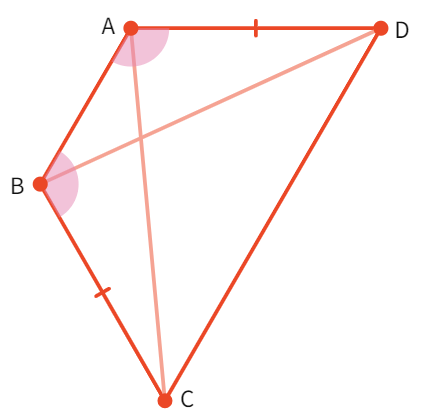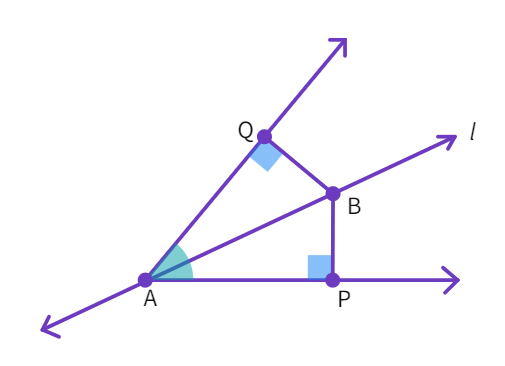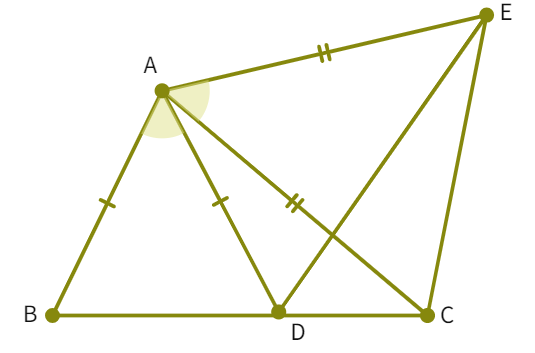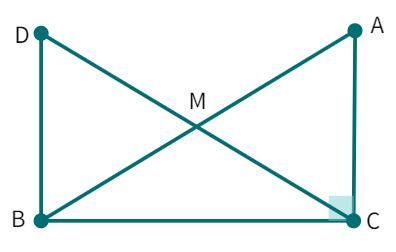Exercise 7.1
1.In quadrilateral ACBD, AC = AD and AB bisects ∠ A. Show that ∆ ABC ≅ ∆ ABD. What can you say about BC and BD?

Solution:
2. ABCD is a quadrilateral in which AD = BC and ∠ DAB = ∠ CBA as shown below. Prove that:

(i) ∆ ABD ≅ ∆ BAC
(ii) BD = AC
(iii) ∠ ABD = ∠ BAC
- Given that: ∠DAB = ∠
and AD = - Consider the triangles ΔABD and ΔBAC:
- AB =
(common arm), ∠ DAB = ∠CBA and AD = BC (given) - By
congruency rule, ΔABD ≅ Δ - By CPCT: BD =
and ∠ ABD = ∠ - Hence, proved.
AD and BC are equal perpendiculars to a line segment AB. Show that CD bisects AB.

Solution:
l and m are two parallel lines intersected by another pair of parallel lines p and q. Show that ∆ ABC ≅ ∆ CDA.

Solution:
5.Line l is the bisector of an angle ∠ A and B is any point on l. BP and BQ are perpendiculars from B to the arms of ∠ A. Show that:

(i) ∆ APB ≅ ∆ AQB
(ii) BP = BQ
- Considering the triangles ΔAPB and ΔAQB: ∠P = ∠
(both are angles) - AB =
(common arm), ∠ BAP = ∠ (Line l is the of angle A) - By
congruency rule, ΔAPB ≅ Δ - By CPCT: BP =
. In other words, the point B is from the arms of ∠A. - Hence, proved.
6.In the below figure we have been given that AC = AE, AB = AD and ∠ BAD = ∠ EAC. Show that BC = DE.

- Given: ∠BAD = ∠CAE. If we add ∠DAC on both sides, we get: ∠BAD + ∠DAC = ∠CAE + ∠DAC i.e. ∠
= ∠ - Considering the triangles ΔABC and ΔADE: AC =
(given) - Also, ∠BAC = ∠DAE (proven) and AB =
(given) - Thus, by
congruency rule: ΔABC ≅ Δ - By CPCT: BC =
- Hence, proved.
7. AB is a line segment and P is its mid-point. D and E are points on the same side of AB such that ∠ BAD = ∠ ABE and ∠ EPA = ∠ DPB as shown. Prove that:

(i) ∆ DAP ≅ ∆ EBP
(ii) AD = BE
- Given: P is the mid-point of line segment AB i.e. AP =
. Also given: ∠BAD = ∠ABE and ∠EPA = ∠DPB - In ∠EPA = ∠DPB, adding ∠DPE on both sides: ∠EPA + ∠DPE = ∠DPB + ∠DPE i.e. ∠
= ∠ - Consider the triangles ΔDAP and ΔEBP: ∠ DPA = ∠
(proven), ∠BAD = ∠ (given) and AP = (given) - By
congruency rule, ΔDAP ≅ Δ - By CPCT: AD =
- Hence, proved.
8. In right triangle ABC, right angled at C, M is the mid-point of hypotenuse AB. C is joined to M and produced to a point D such that DM = CM. Point D is joined to point B as shown below. Prove that:

(i) ∆ AMC ≅ ∆ BMD
(ii) ∠ DBC is a right angle
(iii) ∆ DBC ≅ ∆ ACB
(iv) CM =
- M is the mid-point of the line segment AB i.e.
= BM. Also, ∠C = ° and DM = CM. - Considering the triangles ΔAMC and ΔBMD: AM = BM (given), CM = DM (given) and ∠CMA = ∠
( angles) - By
congruency criterion, ΔAMC ≅ Δ - By CPCT: ∠ACM = ∠
. Further more, they act as angles for the sides AC and BD. - Thus, AC ||
. - We can see that: ∠ ACB + ∠ DBC =
° (co-interiors angles). Thus, 90° + ∠B = 180° i.e. ∠B = ∠ DBC = °. - In the triangles ΔDBC and ΔACB: BC = CB (Common side), ∠ACB = ∠
( angles) and DB = (Corresponding parts of proven Congruent Triangles) - By
congruency rule: ΔDBC ≅ Δ . - By CPCT: DC =
- We already have, DM = CM = AM = BM i.e. the point M is the mid-point for
as well as . - Thus, DM + CM = BM + AM can be re-written as
CM = i.e. CM = AB - Hence, proved.
